Cycle
racing
SKIP
straight to "Leisure cycling and cyle
routes"

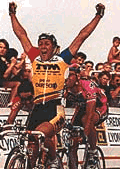 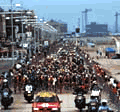 1. Blijlevens winning the stage at Dunkerque in 1995, entitling him to wear the yellow jersey for another day. 2. The mass of riders often travel in a bunch surrounded by the media circus, with TV helicopters overhead. |
Cycle-racing The Tour de France is a complicated race, with over a dozen stages. The route goes all round France, strays briefly into a neighbouring country, and in recent years always ends at the Arc de Triomphe in Paris. Sometimes riders and bikes are transported by van, train or plane from the end of one stage to the start of the next. About two dozen teams compete in the race: each has star riders, who are helped by the others - the domestiques - whose role is to shelter them from the wind, help with cycle breakdowns, and otherwise contribute to the success of their star. The winner of each stage wears the yellow jersey on the next day; the overall winner on total time-so-far wears the green jersey; and the "king of the mountains" (fastest over the gruelling mountain climbs) wears a polka-dot jersey. |
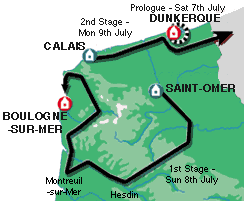 MAP: Opening stages of 2001 Tour de France Click on town names for more information about places on the tour route. |
|
|
The 88th Tour de France 2001 The Prologue in Dunkerque saw time-trials on an 8 km course through the streets of the city, with a finale along the seashore up to the finishing line on Place du Centenaire. The next day, the 200 km first stage took riders from Saint-Omer to Boulogne-sur-Mer, via a loop through the Audomarois nature park, Montreuil-sur-mer and the Boulonnais nature park. The second stage then set off from Calais. Dunkerque is one of the Tour's traditional stopovers. It has hosted a stage on seventeen occasions, first in 1911, during the 9th Tour de France; and most recently in 1995 (stage victory for the sprinter Jeroen Blijlevens). 2001 was the first time the Prologue has been held there. Boulogne-sur-Mer has previously held two stage finishes: Callens won there in 1949, as did the sprinter Van Poppel in 1994. Calais was the starting point for a stage once before, in 1994. As for Saint-Omer, 2001 was its first encounter with the Tour bandwagon. Recommended book | Back to top |
|
|
Weblinks |
|
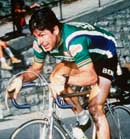 |
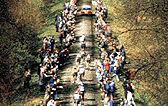 At Wallers an infamous stretch of ancient cobbled highway gives cyclists a rough ride on the annual Paris-Roubaix race, around Easter. |
|
Paris-Roubaix
Race Over the years, the race route has been shifted east towards Valenciennes as roads were renovated and the cobblestones replaced. The race organizers (the Tour de France Society) have also retained strategical bottlenecks where the race can be as easily won or lost - Doullens Hill, Arras, Carvin and the legendary Wattignies bend, were the pivotal stretches of yesteryear; in their place we now find the Wallers-Arenberg Trench in the Scarpe-Escaut Nature Park, Mons-en-Pévèle and the famed Tree-Crossing. The treacherous course has been won by top-notch riders who are amongst the great names of the sport, like Maurice Garin, André Leducq, Rik van Steenbergen, Fausto Coppi, Louison Bobet, Eddy Merckx and Bernard Hinault. For many years, Paris-Roubaix was a Franco-Belgian grudge-match: Belgium has won 47 times to France's 30. In recent decades, Italian riders have also done well: Jules Rossi's victory in 1937, and Coppi's in 1950 opened the way for Francesco Moser, Franco Ballerini and Andrea Tafi. But Belgian rider Roger de Vlaeminck holds the record by winning the race 4 times, having done better than Lapize, Rebry, van Looy, Eddy Merckx and Francesco Moser, each having won the race three times. Riders in this early spring race often face gruelling conditions, with wind, rain and mud adding to the tricky route. Back to top The Official Paris Roubaix Book
Pascal Sergent A Century of Paris Roubaix
Re- live the drama of every Paris Roubaix with the official publication on the event. Photographs and stories depicting the epic classic that is Paris Roubaix
£34.99 |
|
 Get into the atmosphere of the TOUR DE FRANCE with this novel.. Find out more at AMAZON |
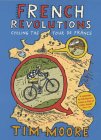 Tim Moore struggles to ride the route of pros in the 2000 Tour de France - a writer like Bill Bryson Find out more at AMAZON |
 Graeme Fife's "Tour de France: The History, The Legend, The Riders" - find out how much has changed since the gruelling race of 1903 Find out more at AMAZON |
|
Places to
visit: |
||
|
Nature parks:
[with
off-road bike trails] |
||
|
Related background
information |
|
|
|
|
|